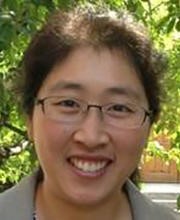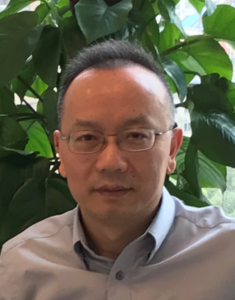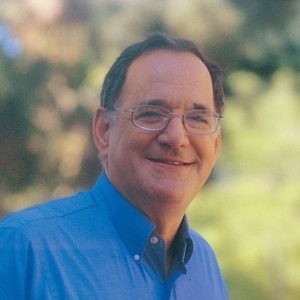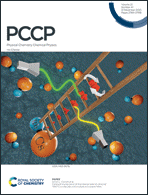 |
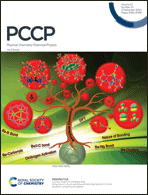 |
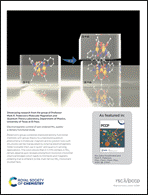 |
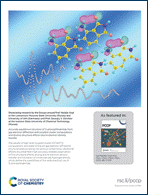 |
| Coherent manipulation of the internal state of ultracold 87Rb133Cs molecules with multiple microwave fields
Jacob A. Blackmore, Philip D. Gregory, Sarah L. Bromley and Simon L. Cornish Phys. Chem. Chem. Phys., 2020, 22, 27529 DOI:10.1039/D0CP04651E |
Intriguing structural, bonding and reactivity features in some beryllium containing complexes
Sudip Pan, Gourhari Jana, Ranajit Saha, Lili Zhao and Pratim K. Chattaraj Phys. Chem. Chem. Phys., 2020, 22, 27476 DOI:10.1039/D0CP04912C |
Electromagnetic control of spin ordered Mn3 qubits: a density functional study
Zahra Hooshmand and Mark R. Pederson Phys. Chem. Chem. Phys., 2020, 22, 27547 DOI:10.1039/D0CP04455E |
Accurate equilibrium structure of 3-aminophthalimide from gas electron diffraction and coupled-cluster computations and diverse structural effects due to electron density transfer
Natalja Vogt, Denis Savelev, Nina I. Giricheva and Georgiy V. Girichev Phys. Chem. Chem. Phys., 2020, 22, 27539 DOI:10.1039/D0CP04423G |
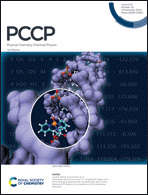 |
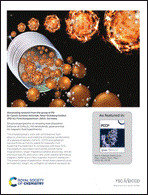 |
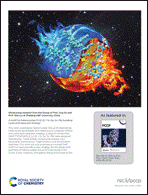 |
|
| Orientation and dynamics of Cu2+ based DNA labels from force field parameterized MD elucidates the relationship between EPR distance constraints and DNA backbone distances
Shreya Ghosh, Joshua Casto, Xiaowei Bogetti, Charu Arora, Junmei Wang and Sunil Saxena Phys. Chem. Chem. Phys., 2020, 22, 26707 DOI:10.1039/D0CP05016D |
Structural perspective on revealing heat dissipation behavior of CoFe2O4–Pd nanohybrids: great promise for magnetic fluid hyperthermia
S. Fatemeh Shams, Mohammad Reza Ghazanfari, Susanne Pettinger, Amir H. Tavabi, Konrad Siemensmeyer, Alevtina Smekhova, Rafal E. Dunin-Borkowski, Gil G. Westmeyer and Carolin Schmitz-Antoniak Phys. Chem. Chem. Phys., 2020, 22, 26728 DOI:10.1039/D0CP02076A |
A motif for heteronuclear CE (E = Si, Ge, Sn, Pb) bonding: Lewis acid–base pair strategy
Jing Xu, Hai-feng Zheng, Wei Liu and Yi-hong Ding Phys. Chem. Chem. Phys., 2020, 22, 26720 DOI:10.1039/D0CP02906H |
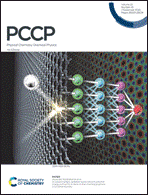 |
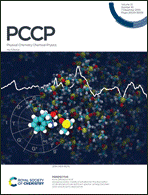 |
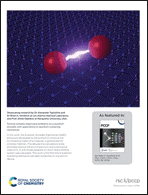 |
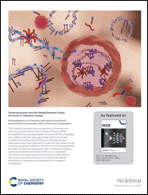 |
| An experimentally validated neural-network potential energy surface for H-atom on free-standing graphene in full dimensionality
Sebastian Wille, Hongyan Jiang, Oliver Bünermann, Alec M. Wodtke, Jörg Behler and Alexander Kandratsenka Phys. Chem. Chem. Phys., 2020, 22, 26113 DOI:10.1039/D0CP03462B |
Assessing cluster models of solvation for the description of vibrational circular dichroism spectra: synergy between static and dynamic approaches
Katia Le Barbu-Debus, Jessica Bowles, Sascha Jähnigen, Carine Clavaguéra, Florent Calvo, Rodolphe Vuilleumier and Anne Zehnacker Phys. Chem. Chem. Phys., 2020, 22, 26047 DOI:10.1039/D0CP03869E |
Solving complex eigenvalue problems on a quantum annealer with applications to quantum scattering resonances
Alexander Teplukhin, Brian K. Kendrick and Dmitri Babikov Phys. Chem. Chem. Phys., 2020, 22, 26136 DOI:10.1039/D0CP04272B |
Mixing behaviour of Pluronics with gemini surfactant/plasmid DNA condensates: effect of Pluronic composition
S. M. Shortall, D. G. Marangoni and S. D. Wettig Phys. Chem. Chem. Phys., 2020, 22, 26121 DOI:10.1039/D0CP00309C |
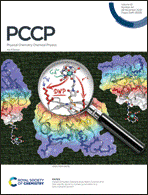 |
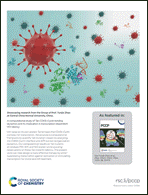 |
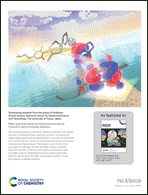 |
|
| Site-specific dynamic nuclear polarization in a Gd(III)-labeled protein
Jörg Heiliger, Tobias Matzel, Erhan Can Çetiner, Harald Schwalbe, Georg Kuenze and Björn Corzilius Phys. Chem. Chem. Phys., 2020, 22, 25455 DOI:10.1039/D0CP05021K |
A computational study of Tat–CDK9–Cyclin binding dynamics and its implication in transcription-dependent HIV latency
Huiwen Wang, Linlu Song, Ting Zhou, Chen Zeng, Ya Jia and Yunjie Zhao Phys. Chem. Chem. Phys., 2020, 22, 25474 DOI:10.1039/D0CP03662E |
Redox potentials along the redox-active low-barrier H-bonds in electron transfer pathways
Keisuke Saito, Manoj Mandal and Hiroshi Ishikita Phys. Chem. Chem. Phys., 2020, 22, 25467 DOI:10.1039/D0CP04265J |
 |
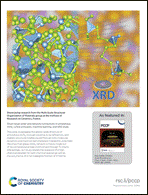 |
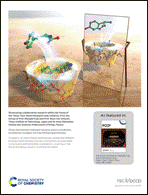 |
|
| Reinterpreting π-stacking
Kevin Carter-Fenk and John M. Herbert Phys. Chem. Chem. Phys., 2020, 22, 24870 DOI:10.1039/D0CP05039C |
Short range order and network connectivity in amorphous AsTe3: a first principles, machine learning, and XRD study
Gaëlle Delaizir, Andrea Piarristeguy, Annie Pradel, Olivier Masson and Assil Bouzid Phys. Chem. Chem. Phys., 2020, 22, 24895 DOI:10.1039/D0CP03383A |
Chiral discrimination between tyrosine and β-cyclodextrin revealed by cryogenic ion trap infrared spectroscopy
Keisuke Hirata, Yuta Mori, Shun-ichi Ishiuchi, Masaaki Fujii and Anne Zehnacker Phys. Chem. Chem. Phys., 2020, 22, 24887 DOI:10.1039/D0CP02968H |
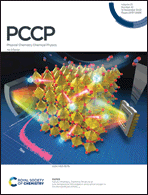 |
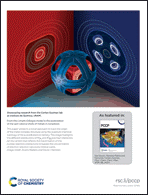 |
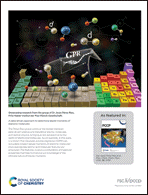 |
|
| Low-temperature NO oxidation using lattice oxygen in Fe-site substituted SrFeO3−δ
Kazuki Tamai, Saburo Hosokawa, Kazuo Kato, Hiroyuki Asakura, Kentaro Teramura and Tsunehiro Tanaka Phys. Chem. Chem. Phys., 2020, 22, 24181 DOI:10.1039/D0CP03726E |
From the Linnett–Gillespie model to the polarization of the spin valence shells of metals in complexes
David I. Ramírez-Palma and Fernando Cortés-Guzmán Phys. Chem. Chem. Phys., 2020, 22, 24201 DOI:10.1039/D0CP02064H |
A data-driven approach to determine dipole moments of diatomic molecules
Xiangyue Liu, Gerard Meijer and Jesús Pérez-Ríos Phys. Chem. Chem. Phys., 2020, 22, 24191 DOI:10.1039/D0CP03810E |
|
 |
 |
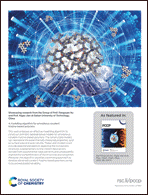 |
|
| Pyrocatalytic oxidation – strong size-dependent poling effect on catalytic activity of pyroelectric BaTiO3 nano- and microparticles
Sascha Raufeisen, Peter Neumeister, Johannes R. Buchheim, Michael Stelter and Patrick Braeutigam Phys. Chem. Chem. Phys., 2020, 22, 23464 DOI:10.1039/D0CP03158E |
Plasmon catalytic PATP coupling reaction on Ag-NPs/graphite studied via in situ electrochemical surface-enhanced Raman spectroscopy
Hang Zhong, Jun Chen, Jinfan Chen, Ran Tao, Jiaolai Jiang, Yi Hu, Jingsong Xu, Tianzhu Zhang and Junsheng Liao Phys. Chem. Chem. Phys., 2020, 22, 23482 DOI:10.1039/D0CP01733G |
A modelling algorithm for amorphous covalent triazine-based polymers
Ce Song, Fangyuan Hu, Zhaoliang Meng, Shengming Li, Tianpeng Zhang, Wenlong Shao, Siyang Liu and Xigao Jian Phys. Chem. Chem. Phys., 2020, 22, 23474 DOI:10.1039/D0CP01277G |
 |
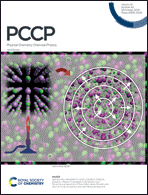 |
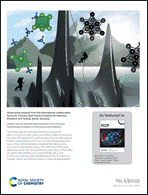 |
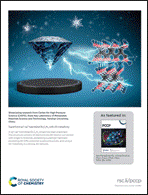 |
| Harnessing deep neural networks to solve inverse problems in quantum dynamics: machine-learned predictions of time-dependent optimal control fields
Xian Wang, Anshuman Kumar, Christian R. Shelton and Bryan M. Wong Phys. Chem. Chem. Phys., 2020, 22, 22889 DOI:10.1039/D0CP03694C |
Structure and dynamics of the molten alkali-chloride salts from an X-ray, simulation, and rate theory perspective
Santanu Roy, Fei Wu, Haimeng Wang, Alexander S. Ivanov, Shobha Sharma, Phillip Halstenberg, Simerjeet K Gill, A. M. Milinda Abeykoon, Gihan Kwon, Mehmet Topsakal, Bobby Layne, Kotaro Sasaki, Yong Zhang, Shannon M. Mahurin, Sheng Dai, Claudio J. Margulis, Edward J. Maginn and Vyacheslav S. Bryantsev Phys. Chem. Chem. Phys., 2020, 22, 22900 DOI:10.1039/D0CP03672B |
Insight into the thermal decomposition of ammonium hexahalogenoiridates(IV) and hexachloroiridate(III)
Kirill V. Yusenko, Valentina V. Zvereva, Svetlana A. Martynova, Igor P. Asanov, Camille La Fontaine, Olga Roudenko, Alexander I. Gubanov, Pavel E. Plyusnin, Sergey V. Korenev and Tatyana I. Asanova Phys. Chem. Chem. Phys., 2020, 22, 22923 DOI:10.1039/D0CP02743J |
Superhard sp2–sp3 hybridized B2C3N2 with 2D metallicity
Baozhong Li, Yang Zhang, Kun Luo, Chenlong Xie, Yufei Gao, Lingjuan Hao, Yingju Wu, Shuangshuang Zhang, Mengdong Ma, Zhisheng Zhao and Julong He Phys. Chem. Chem. Phys., 2020, 22, 22918 DOI:10.1039/D0CP03196H |
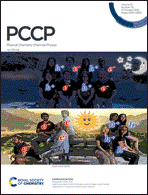 |
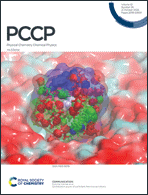 |
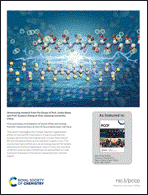 |
 |
| Light and electric field induced unusual large-scale charge separation in hybrid semiconductor objects
Ambrose A. Melvin, Eric Lebraud, Patrick Garrigue and Alexander Kuhn Phys. Chem. Chem. Phys., 2020, 22, 22180 DOI:10.1039/D0CP03262J |
Solubilization power of surfactant-free microemulsions
Sebastian Schöttl, Nobuyuki Matubayasi and Dominik Horinek Phys. Chem. Chem. Phys., 2020, 22, 22185 DOI:10.1039/D0CP02933E |
First-principles investigation of band offset and charge transfer characteristics at the PE/fluorinated layer interface
Xi Chen, Guangzhi Guo, Yifan Hao, Jiaming Li, Wendong Li, Junbo Deng, Guanjun Zhang and Mingming Zhai Phys. Chem. Chem. Phys., 2020, 22, 22207 DOI:10.1039/D0CP01992E |
Nuclear spin-induced optical rotation of functional groups in hydrocarbons
Petr Štěpánek Phys. Chem. Chem. Phys., 2020, 22, 22195 DOI:10.1039/D0CP02856H |
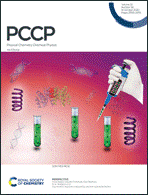 |
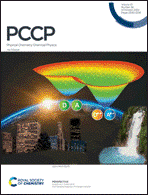 |
 |
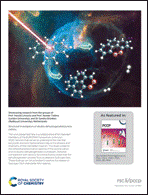 |
| Asymmetric reactions induced by electron spin polarization
B. P. Bloom, Y. Lu, Tzuriel Metzger, Shira Yochelis, Yossi Paltiel, Claudio Fontanesi, Suryakant Mishra, Francesco Tassinari, Ron Naaman and D. H. Waldeck Phys. Chem. Chem. Phys., 2020, 22, 21570 DOI:10.1039/D0CP03129A |
Multifaceted aspects of charge transfer
James B. Derr, Jesse Tamayo, John A. Clark, Maryann Morales, Maximillian F. Mayther, Eli M. Espinoza, Katarzyna Rybicka-Jasińska and Valentine I. Vullev Phys. Chem. Chem. Phys., 2020, 22, 21583 DOI:10.1039/D0CP01556C |
Lifetime and diffusion distance of singlet oxygen in air under everyday atmospheric conditions
Kang-Kyun Wang, Sanggeun Song, Seung-Jin Jung, Jung-Wook Hwang, Min-Goo Kim, Ji-Hyun Kim, Jaeyoung Sung, Jin-Kyu Lee and Yong-Rok Kim Phys. Chem. Chem. Phys., 2020, 22, 21664 DOI:10.1039/D0CP00739K |
Structural investigation of doubly-dehydrogenated pyrene cations
Sanjana Panchagnula, Jordy Bouwman, Daniël B. Rap, Pablo Castellanos, Alessandra Candian, Cameron Mackie, Shreyak Banhatti, Sandra Brünken, Harold Linnartz and Alexander G. G. M. Tielens Phys. Chem. Chem. Phys., 2020, 22, 21651 DOI:10.1039/D0CP02272A |
 |
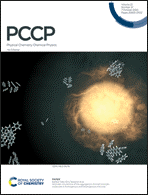 |
 |
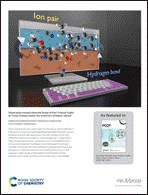 |
| Energy dispersive X-ray diffraction (EDXRD) for operando materials characterization within batteries
Amy C. Marschilok, Andrea M. Bruck, Alyson Abraham, Chavis A. Stackhouse, Kenneth J. Takeuchi, Esther S. Takeuchi, Mark Croft and Joshua W. Gallaway Phys. Chem. Chem. Phys., 2020, 22, 20972 DOI:10.1039/D0CP00778A |
Atomistic simulations of the aggregation of small aromatic molecules in homogenous and heterogenous mixtures
Michael Thomas, Irene Suarez-Martinez, Li-Juan Yu, Amir Karton, Graham S. Chandler, Marc Robinson, Isabelle Cherchneff, Dahbia Talbi and Dino Spagnoli Phys. Chem. Chem. Phys., 2020, 22, 21005 DOI:10.1039/D0CP02622K |
Distance measurements between carbon and bromine using a split-pulse PM-RESPDOR solid-state NMR experiment
M. Makrinich, M. Sambol and A. Goldbourt Phys. Chem. Chem. Phys., 2020, 22, 21022 DOI:10.1039/D0CP01162B |
Improving phase-transfer catalysis by enhancing non-covalent interactions
Iñigo Iribarren and Cristina Trujillo Phys. Chem. Chem. Phys., 2020, 22, 21015 DOI:10.1039/D0CP02012E |
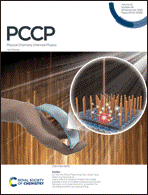 |
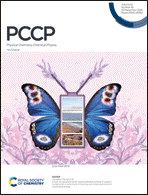 |
 |
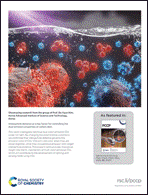 |
| Highly efficient utilization of light and charge separation over a hematite photoanode achieved through a noncontact photonic crystal film for photoelectrochemical water splitting
Wen-Yuan Yu, De-Kun Ma, Dong-Peng Yang, Xiao-Gang Yang, Quan-Long Xu, Wei Chen and Shaoming Huang Phys. Chem. Chem. Phys., 2020, 22, 20202 DOI:10.1039/D0CP00284D |
A tool for deciphering the redox potential ranking of organic compounds: a case study of biomass-extracted quinones for sustainable energy
Fanny Lambert, Yann Danten, Carlo Gatti and Christine Frayret Phys. Chem. Chem. Phys., 2020, 22, 20212 DOI:10.1039/D0CP02045A |
Chemical bonding in cuprous complexes with simple nitriles: octet rule and resonance concepts versus quantitative charge-redistribution analysis
Simone Potenti, Lorenzo Paoloni, Surajit Nandi, Marco Fusè, Vincenzo Barone and Sergio Rampino Phys. Chem. Chem. Phys., 2020, 22, 20238 DOI:10.1039/D0CP01536A |
Interparticle distance as a key factor for controlling the dual-emission properties of carbon dots
Hyo Jeong Yoo, Byeong Eun Kwak and Do Hyun Kim Phys. Chem. Chem. Phys., 2020, 22, 20227 DOI:10.1039/D0CP02120B |
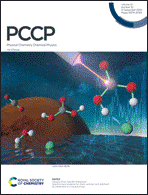 |
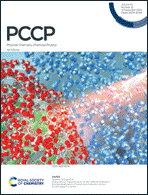 |
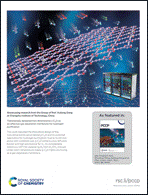 |
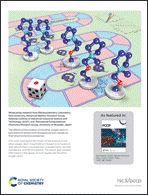 |
| Spectroscopic evidence for intact carbonic acid stabilized by halide anions in the gas phase
Hanhui Zhang, Wenjin Cao, Qinqin Yuan, Lei Wang, Xiaoguo Zhou, Shilin Liu and Xue-Bin Wang Phys. Chem. Chem. Phys., 2020, 22, 19459 DOI:10.1039/D0CP02338H |
Highly precise characterization of the hydration state upon thermal denaturation of human serum albumin using a 65 GHz dielectric sensor
Keiichiro Shiraga, Mako Urabe, Takeshi Matsui, Shojiro Kikuchi and Yuichi Ogawa Phys. Chem. Chem. Phys., 2020, 22, 19468 DOI:10.1039/D0CP02265A |
Theoretically designed two-dimensional γ-C4O as an effective gas separation membrane for hydrogen purification
Cai Ning, Yadong Zhang, Jing Wang, Haiqi Gao, Chuanyun Xiao, Zhaoshun Meng and Huilong Dong Phys. Chem. Chem. Phys., 2020, 22, 19492 DOI:10.1039/D0CP02640A |
The effects of the position of the ether oxygen atom in pyrrolidinium-based room temperature ionic liquids on their physicochemical properties
Kazuki Yoshii, Takuya Uto, Naoki Tachikawa and Yasushi Katayama Phys. Chem. Chem. Phys., 2020, 22, 19480 DOI:10.1039/D0CP02662J |
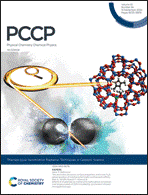 |
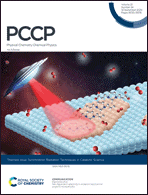 |
 |
 |
| The electronic structure, surface properties, and in situ N2O decomposition of mechanochemically synthesised LaMnO3
Rachel H. Blackmore, Maria Elena Rivas, George F. Tierney, Khaled M. H. Mohammed, Donato Decarolis, Shusaku Hayama, Federica Venturini, Georg Held, Rosa Arrigo, Monica Amboage, Pip Hellier, Evan Lynch, Mahrez Amri, Marianna Casavola, Tugce Eralp Erden, Paul Collier and Peter P. Wells Phys. Chem. Chem. Phys., 2020, 22, 18774 DOI:10.1039/D0CP00793E |
Site-dependent selectivity in oxidation reactions on single Pt nanoparticles
Shahar Dery, Suhong Kim, Daniel Feferman, Hillel Mehlman, F. Dean Toste and Elad Gross Phys. Chem. Chem. Phys., 2020, 22, 18765 DOI:10.1039/D0CP00642D |
CuO/La0.5Sr0.5CoO3: precursor of efficient NO reduction catalyst studied by operando high energy X-ray diffraction under three-way catalytic conditions
Ivo Alxneit, Alberto Garbujo, Giovanni Carollo, Davide Ferri and Antonella Glisenti Phys. Chem. Chem. Phys., 2020, 22, 18798 DOI:10.1039/D0CP01064B |
Elucidating the mechanism of the CO2 methanation reaction over Ni–Fe hydrotalcite-derived catalysts via surface-sensitive in situ XPS and NEXAFS
Gianfranco Giorgianni, Chalachew Mebrahtu, Manfred Erwin Schuster, Alexander Ian Large, Georg Held, Pilar Ferrer, Federica Venturini, David Grinter, Regina Palkovits, Siglinda Perathoner, Gabriele Centi, Salvatore Abate and Rosa Arrigo Phys. Chem. Chem. Phys., 2020, 22, 18788 DOI:10.1039/D0CP00622J |
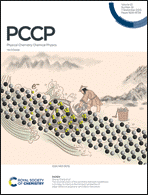 |
 |
 |
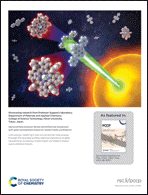 |
| The reconstruction of the symmetry between sublattices: a strategy to improve the transport properties of edge-defective graphene nanoribbon transistors
Shizhuo Ye, Hao Wang, Minzheng Qiu, Yi Zeng, Qijun Huang, Jin He and Sheng Chang Phys. Chem. Chem. Phys., 2020, 22, 18265 DOI:10.1039/D0CP01684E |
Puja Adhikari, Neng Li, Matthew Shin, Nicole F. Steinmetz, Reidun Twarock, Rudolf Podgornik and Wai-Yim Ching Phys. Chem. Chem. Phys., 2020, 22, 18272 DOI:10.1039/D0CP03145C |
A first-principles study on the magnetoelectric coupling induced by Fe in a two-dimensional BaTiO3(001) ultrathin film
Haigen Gao, Tongzheng Lin, Yunjuan Yan, Kang Fu, Yande Liu and Xiaolong Liu Phys. Chem. Chem. Phys., 2020, 22, 18284 DOI:10.1039/D0CP01968B |
Upconverted emission-driven photothermal conversion with gold nanospheres based on triplet–triplet annihilation
Shota Jin, Kosuke Sugawa, Naoto Takeshima, Shuto Igari, Wataru Inoue, Jotaro Honda, Satoshi Yoshinari, Shiryu Watanabe, Daisuke Kanai, Kotomi Kanakubo and Joe Otsuki Phys. Chem. Chem. Phys., 2020, 22, 18257 DOI:10.1039/D0CP02365E |
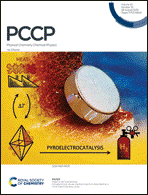 |
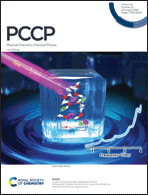 |
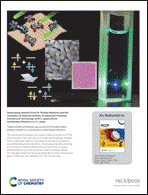 |
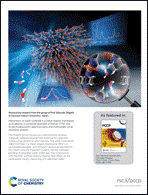 |
| Pyroelectrically-driven chemical reactions described by a novel thermodynamic cycle
Mateo U. de Vivanco, Matthias Zschornak, Hartmut Stöcker, Sven Jachalke, Erik Mehner, Tilmann Leisegang and Dirk C. Meyer Phys. Chem. Chem. Phys., 2020, 22, 17781 DOI:10.1039/D0CP01288B |
Probing NaCl hydrate formation from aqueous solutions by terahertz time-domain spectroscopy
Ligang Chen, Guanhua Ren, Liyuan Liu, Pan Guo, Endong Wang, Zhongjie Zhu, Jinrong Yang, Jianxiong Shen, Zongchang Zhang, Lu Zhou, Jianbing Zhang, Bin Yang, Weili Zhang, Yi Gao, Hongwei Zhao and Jiaguang Han Phys. Chem. Chem. Phys., 2020, 22, 17791 DOI:10.1039/D0CP01571G |
Triplet–triplet annihilation upconversion through triplet energy transfer at a nanoporous solid–liquid interface
Toshiko Mizokuro, Aizitiaili Abulikemu, Kengo Suzuki, Yusuke Sakagami, Ritsuki Nishii, Tetsuro Jin and Kenji Kamada Phys. Chem. Chem. Phys., 2020, 22, 17807 DOI:10.1039/D0CP01735C |
Interactions of water confined in a metal–organic framework as studied by a combined approach of Raman, FTIR, and IR electroabsorption spectroscopies and multivariate curve resolution analysis
Takayuki Hiraoka and Shinsuke Shigeto Phys. Chem. Chem. Phys., 2020, 22, 17798 DOI:10.1039/D0CP02958K |
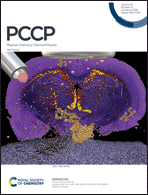 |
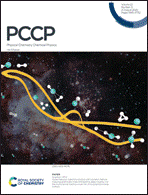 |
 |
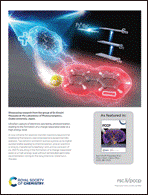 |
| Large cluster ions: soft local probes and tools for organic and bio surfaces
Arnaud Delcorte, Vincent Delmez, Christine Dupont-Gillain, Clément Lauzin, Hannah Jefford, Mykhailo Chundak, Claude Poleunis and Konstantin Moshkunov Phys. Chem. Chem. Phys., 2020, 22, 17427 DOI:10.1039/D0CP02398A |
Quasi-classical trajectory analysis with isometric feature mapping and locally linear embedding: deep insights into the multichannel reaction on an NH3+(4A) potential energy surface
Weiliang Shi, Tian Jia and Anyang Li Phys. Chem. Chem. Phys., 2020, 22, 17460 DOI:10.1039/D0CP01941K |
C–H⋯S interaction exhibits all the characteristics of conventional hydrogen bonds
Sanat Ghosh, Pragya Chopra and Sanjay Wategaonkar Phys. Chem. Chem. Phys., 2020, 22, 17482 DOI:10.1039/D0CP01508C |
Tomomi Kawakami, Masafumi Koga, Hikaru Sotome and Hiroshi Miyasaka Phys. Chem. Chem. Phys., 2020, 22, 17472 DOI:10.1039/D0CP02029J |
 |
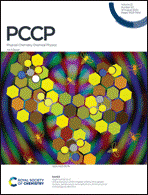 |
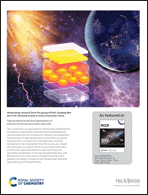 |
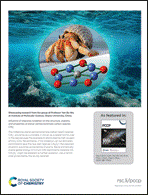 |
| Benchmarking a new segmented K-band chirped-pulse microwave spectrometer and its application to the conformationally rich amino alcohol isoleucinol
Mariyam Fatima, Cristóbal Pérez, Benjamin E. Arenas, Melanie Schnell and Amanda L. Steber Phys. Chem. Chem. Phys., 2020, 22, 17042 DOI:10.1039/D0CP01141J |
Characterization of the simplest sulfenyl thiocyanate: isomers, spectroscopy and implications of astrophysical and biological relevance
Aicha Benabdelkrim, Ala Eddine Tourchi, Dalila Hammoutène, Saida Ben Yaghlane, Hassan H. Abdallah, Roberto Linguerri and Majdi Hochlaf Phys. Chem. Chem. Phys., 2020, 22, 17052 DOI:10.1039/D0CP02382E |
Optical-electrical-thermal optimization of plasmon-enhanced perovskite solar cells
Hao Ren, Xingang Ren, Kaikun Niu, Siliang Wang, Zhixiang Huang and Xianliang Wu Phys. Chem. Chem. Phys., 2020, 22, 17068 DOI:10.1039/D0CP02220A |
Influence of stepwise oxidation on the structure, stability, and properties of planar pentacoordinate carbon species CAl5+
Rui Sun, Xue-Feng Zhao, Bo Jin, Bin Huo, Jian-Hong Bian, Xiao-Ling Guan, Caixia Yuan and Yan-Bo Wu Phys. Chem. Chem. Phys., 2020, 22, 17062 DOI:10.1039/D0CP01106A |
 |
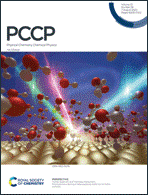 |
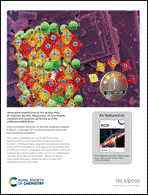 |
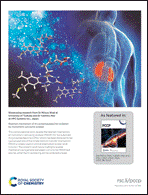 |
| Excitation energy transport in DNA modelled by multi-chromophoric field-induced surface hopping
Matthias Wohlgemuth and Roland Mitrić Phys. Chem. Chem. Phys., 2020, 22, 16536 DOI:10.1039/D0CP02255A |
Orientational ordering in heteroepitaxial water ice on metal surfaces
Toshiki Sugimoto and Yoshiyasu Matsumoto Phys. Chem. Chem. Phys., 2020, 22, 16453 DOI:10.1039/D0CP01763A |
Intra-octahedral distortion on lamellar potassium niobate K4Nb6O17: a periodic DFT study of structural, electronic and vibrational properties
Juliana Kelly D. Souza, Thiago M. Duarte, Iêda Maria Garcia dos Santos, Júlio Ricardo Sambrano, Ary da Silva Maia and Anderson dos Reis Albuquerque Phys. Chem. Chem. Phys., 2020, 22, 16562 DOI:10.1039/D0CP01581D |
Reaction mechanism of N-cyclopropylglycine oxidation by monomeric sarcosine oxidase
Mitsuo Shoji, Yukihiro Abe, Mauro Boero, Yasuteru Shigeta and Yoshiaki Nishiya Phys. Chem. Chem. Phys., 2020, 22, 16552 DOI:10.1039/D0CP01679A |
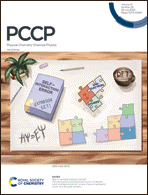 |
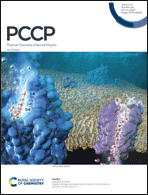 |
 |
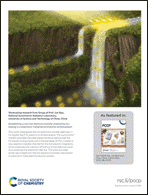 |
| The one-electron self-interaction error in 74 density functional approximations: a case study on hydrogenic mono- and dinuclear systems
Dale R. Lonsdale and Lars Goerigk Phys. Chem. Chem. Phys., 2020, 22, 15805 DOI:10.1039/D0CP01275K |
Rigidly hydrogen-bonded water molecules facilitate proton transfer in photosystem II
Naoki Sakashita, Hiroshi Ishikita and Keisuke Saito Phys. Chem. Chem. Phys., 2020, 22, 15831 DOI:10.1039/D0CP00295J |
Impact of anion shape on Li+ solvation and on transport properties for lithium–air batteries: a molecular dynamics study
Juliane Fiates, Yong Zhang, Luís F. M. Franco, Edward J. Maginn and Gustavo Doubek Phys. Chem. Chem. Phys., 2020, 22, 15842 DOI:10.1039/D0CP00853B |
Establishing a new hot electrons transfer channel by ion doping in a plasmonic metal/semiconductor photocatalyst
Zhiyu Wang, Jiawei Xue, Haibin Pan, Lihui Wu, Jingjing Dong, Heng Cao, Song Sun, Chen Gao, Xiaodi Zhu and Jun Bao Phys. Chem. Chem. Phys., 2020, 22, 15795 DOI:10.1039/D0CP01625J |
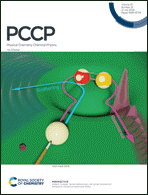 |
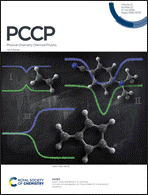 |
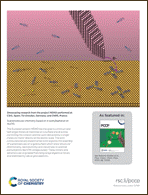 |
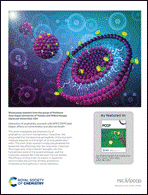 |
| Rotational–vibrational resonance states
Attila G. Császár, Irén Simkó, Tamás Szidarovszky, Gerrit C. Groenenboom, Tijs Karman and Ad van der Avoird Phys. Chem. Chem. Phys., 2020, 22, 15081 DOI:10.1039/D0CP00960A |
A molecular perspective on Tully models for nonadiabatic dynamics
Lea M. Ibele and Basile F. E. Curchod Phys. Chem. Chem. Phys., 2020, 22, 15183 DOI:10.1039/D0CP01353F |
Supramolecular chemistry based on 4-acetylbiphenyl on Au(111)
Roberto Robles, Vladimír Zobač, Kwan Ho Au Yeung, Francesca Moresco, Christian Joachim and Nicolás Lorente Phys. Chem. Chem. Phys., 2020, 22, 15208 DOI:10.1039/D0CP01657H |
Interaction of amphiphilic coumarin with DPPC/DPPS lipid bilayer: effects of concentration and alkyl tail length
Poornima Kalyanram, Huilin Ma, Shena Marshall, Christina Goudreau, Ana Cartaya, Tyler Zimmermann, Istvan Stadler, Shikha Nangia and Anju Gupta Phys. Chem. Chem. Phys., 2020, 22, 15197 DOI:10.1039/D0CP00696C |
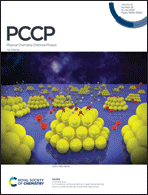 |
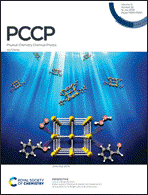 |
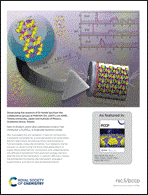 |
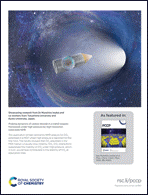 |
| C–H oxidation enhancement on a gold nanoisland by atomic-undercoordination induced polarization
Zezhou Lin, Hajime Hirao, Changqing Sun and Xi Zhang Phys. Chem. Chem. Phys., 2020, 22, 14458 DOI:10.1039/D0CP01117G |
Metal–organic framework-based nanomaterials for photocatalytic hydrogen peroxide production
Xiaolang Chen, Yoshifumi Kondo, Yasutaka Kuwahara, Kohsuke Mori, Catherine Louis and Hiromi Yamashita Phys. Chem. Chem. Phys., 2020, 22, 14404 DOI:10.1039/D0CP01759K |
Role of divalent cation (Ba) substitution in the Li+ ion conductor LiTi2(PO4)3: a molecular dynamics study
Kartik Sau, Tamio Ikeshoji and Supriya Roy Phys. Chem. Chem. Phys., 2020, 22, 14471 DOI:10.1039/D0CP01053G |
Probing dynamics of carbon dioxide in a metal–organic framework under high pressure by high-resolution solid-state NMR
Munehiro Inukai, Takuya Kurihara, Yasuto Noda, Weiming Jiang, Kiyonori Takegoshi, Naoki Ogiwara, Hiroshi Kitagawa and Koichi Nakamura Phys. Chem. Chem. Phys., 2020, 22, 14465 DOI:10.1039/D0CP01216E |
 |
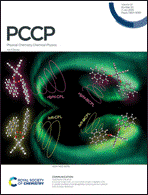 |
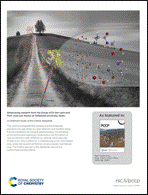 |
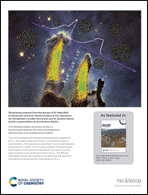 |
| Pseudo-ternary LiBH4·LiCl·P2S5 system as structurally disordered bulk electrolyte for all-solid-state lithium batteries
Abdelouahab El Kharbachi, Julia Wind, Amund Ruud, Astrid B. Høgset, Magnus M. Nygård, Junxian Zhang, Magnus H. Sørby, Sangryun Kim, Fermin Cuevas, Shin-ichi Orimo, Maximilian Fichtner, Michel Latroche, Helmer Fjellvåg and Bjørn C. Hauback Phys. Chem. Chem. Phys., 2020, 22, 13872 DOI:10.1039/D0CP01334J |
Excimer-origin CPL vs. monomer-origin magnetic CPL in photo-excited chiral binaphthyl-ester-pyrenes: critical role of ester direction
Hana Okada, Nobuyuki Hara, Daiki Kaji, Motohiro Shizuma, Michiya Fujuiki and Yoshitane Imai Phys. Chem. Chem. Phys., 2020, 22, 13862 DOI:10.1039/D0CP02215B |
A rotational study of the AlaAla dipeptide
I. León, E. R. Alonso, S. Mata and J. L. Alonso Phys. Chem. Chem. Phys., 2020, 22, 13867 DOI:10.1039/D0CP01043J |
VUV photoionization dynamics of the C60 buckminsterfullerene: 2D-matrix photoelectron spectroscopy in an astrophysical context
Helgi Rafn Hrodmarsson, Gustavo A. Garcia, Harold Linnartz and Laurent Nahon Phys. Chem. Chem. Phys., 2020, 22, 13880 DOI:10.1039/D0CP01210F |
 |
 |
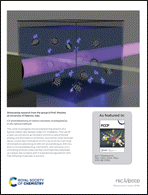 |
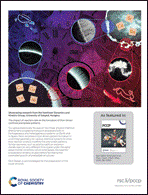 |
| Density functional theory study of superoxide ions as impurities in alkali halides
Alexander S. Tygesen, Nicolai R. Mathiesen, Jin Hyun Chang and Juan María García-Lastra Phys. Chem. Chem. Phys., 2020, 22, 13378 DOI:10.1039/D0CP00719F |
In cell Gd3+-based site-directed spin labeling and EPR spectroscopy of eGFP
Svetlana Kucher, Sergej Korneev, Johann P. Klare, Daniel Klose and Heinz-Jürgen Steinhoff Phys. Chem. Chem. Phys., 2020, 22, 13358 DOI:10.1039/D0CP01930E |
UV photobleaching of carbon nanodots investigated by in situ optical methods
A. V. Longo, A. Sciortino, M. Cannas and F. Messina Phys. Chem. Chem. Phys., 2020, 22, 13398 DOI:10.1039/D0CP00952K |
The impact of reaction rate on the formation of flow-driven confined precipitate patterns
Edina Balog, Paszkál Papp, Ágota Tóth, Dezső Horváth and Gábor Schuszter Phys. Chem. Chem. Phys., 2020, 22, 13390 DOI:10.1039/D0CP01036G |
 |
 |
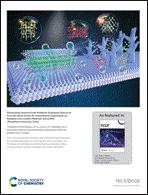 |
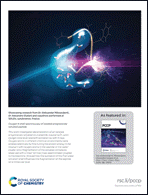 |
| Signature of a conical intersection in the dissociative photoionization of formaldehyde
Alexandre Zanchet, Gustavo A. García, Laurent Nahon, Luis Bañares and Sonia Marggi Poullain Phys. Chem. Chem. Phys., 2020, 22, 12886 DOI:10.1039/D0CP01267J |
Substrate water exchange in the S2 state of photosystem II is dependent on the conformation of the Mn4Ca cluster
Casper de Lichtenberg and Johannes Messinger Phys. Chem. Chem. Phys., 2020, 22, 12894 DOI:10.1039/D0CP01380C |
Theoretical formulation of Li3a+bNaXb (X = halogen) as a potential artificial solid electrolyte interphase (ASEI) to protect the Li anode
Junwu Sang, Yuran Yu, Zhuo Wang and Guosheng Shao Phys. Chem. Chem. Phys., 2020, 22, 12918 DOI:10.1039/D0CP00151A |
Oxygen K-shell spectroscopy of isolated progressively solvated peptide
Aleksandar R. Milosavljević, Kari Jänkälä, Miloš Lj. Ranković, Francis Canon, John Bozek, Christophe Nicolas and Alexandre Giuliani Phys. Chem. Chem. Phys., 2020, 22, 12909 DOI:10.1039/D0CP00994F |
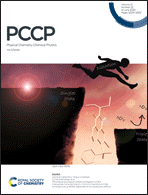 |
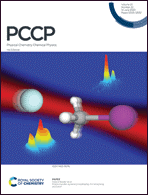 |
 |
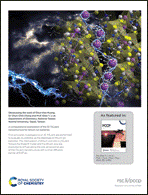 |
| Theoretical and experimental investigation on the intersystem crossing kinetics in benzothioxanthene imide luminophores, and their dependence on substituent effects
Laura Abad Galán, José M. Andrés Castán, Clément Dalinot, Pablo Simón Marqués, Philippe Blanchard, Olivier Maury, Clément Cabanetos, Tangui Le Bahers and Cyrille Monnereau Phys. Chem. Chem. Phys., 2020, 22, 12373 DOI:10.1039/D0CP01072C |
Proton transfer dynamics modified by CH-stretching excitation
Tim Michaelsen, Björn Bastian, Patrick Strübin, Jennifer Meyer and Roland Wester Phys. Chem. Chem. Phys., 2020, 22, 12382 DOI:10.1039/D0CP00727G |
Chemical potentials of electric double layers at metal–electrolyte interfaces: dependence on electrolyte concentration and electrode materials, and application to field-effect transistors
Chihiro Nanjo, Daisuke Yokogawa, Michio M. Matsushita and Kunio Awaga Phys. Chem. Chem. Phys., 2020, 22, 12395 DOI:10.1039/D0CP00423E |
A computational exploration of the 1D TiS2(en) nanostructure for lithium ion batteries
Chun-Hao Huang, Chun-Chih Chang and Elise Y. Li Phys. Chem. Chem. Phys., 2020, 22, 12389 DOI:10.1039/C9CP04675E |
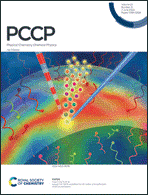 |
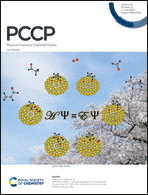 |
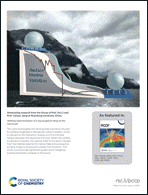 |
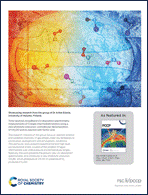 |
| Liquid ToF-SIMS revealing the oil, water, and surfactant interface evolution
Yanjie Shen, Jenn Yao, Jiyoung Son, Zihua Zhu and Xiao-Ying Yu Phys. Chem. Chem. Phys., 2020, 22, 11771 DOI:10.1039/D0CP00528B |
Propene oxidation catalysis and electronic structure of M55 particles (M = Pd or Rh): differences and similarities between Pd55 and Rh55
Bo Zhu, Masahiro Ehara and Shigeyoshi Sakaki Phys. Chem. Chem. Phys., 2020, 22, 11783 DOI:10.1039/D0CP00169D |
Wetting state transition of a liquid gallium drop at the nanoscale
Meng Yan, Tao Li, Peiru Zheng, Rubin Wei, Yanyan Jiang and Hui Li Phys. Chem. Chem. Phys., 2020, 22, 11809 DOI:10.1039/D0CP00985G |
Time-resolved, broadband UV-absorption spectrometry measurements of Criegee intermediate kinetics using a new photolytic precursor: unimolecular decomposition of CH2OO and its reaction with formic acid
Jari Peltola, Prasenjit Seal, Anni Inkilä and Arkke Eskola Phys. Chem. Chem. Phys., 2020, 22, 11797 DOI:10.1039/D0CP00302F |
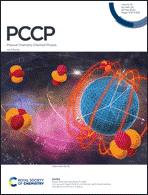 |
 |
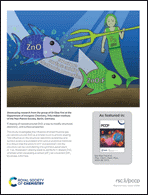 |
 |
| The dynamic ligand field of a molecular qubit: decoherence through spin–phonon coupling
Ruben Mirzoyan and Ryan G. Hadt Phys. Chem. Chem. Phys., 2020, 22, 11249 DOI:10.1039/D0CP00852D |
Universal crossed beam imaging studies of polyatomic reaction dynamics
Hongwei Li and Arthur G. Suits Phys. Chem. Chem. Phys., 2020, 22, 11126 DOI:10.1039/D0CP00522C |
F-doping of nanostructured ZnO: a way to modify structural, electronic, and surface properties
Elisabeth Hannah Wolf, Marie-Mathilde Millet, Friedrich Seitz, Frenio A. Redeker, Wiebke Riedel, Gudrun Scholz, Walid Hetaba, Detre Teschner, Sabine Wrabetz, Frank Girgsdies, Alexander Klyushin, Thomas Risse, Sebastian Riedel and Elias Frei Phys. Chem. Chem. Phys., 2020, 22, 11273 DOI:10.1039/D0CP00545B |
Monolayer Ti2C MXene: manipulating magnetic properties and electronic structures by an electric field
Peng Lv, Yan-Li Li and Jia-Fu Wang Phys. Chem. Chem. Phys., 2020, 22, 11266 DOI:10.1039/D0CP00507J |
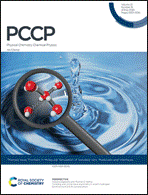 |
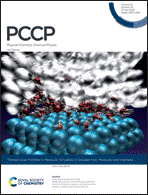 |
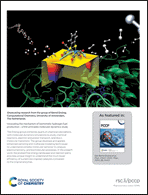 |
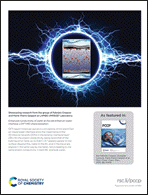 |
| Tumbling with a limp: local asymmetry in water’s hydrogen bond network and its consequences
Hossam Elgabarty and Thomas D. Kühne Phys. Chem. Chem. Phys., 2020, 22, 10397 DOI:10.1039/C9CP06960G |
Water structures on a Pt(111) electrode from ab initio molecular dynamic simulations for a variety of electrochemical conditions
Sung Sakong and Axel Groß Phys. Chem. Chem. Phys., 2020, 22, 10431 DOI:10.1039/C9CP06584A |
Unraveling the mechanism of biomimetic hydrogen fuel production – a first principles molecular dynamics study
Rakesh C. Puthenkalathil, Mihajlo Etinski and Bernd Ensing Phys. Chem. Chem. Phys., 2020, 22, 10447 DOI:10.1039/C9CP06770A |
Enhanced conductivity of water at the electrified air–water interface: a DFT-MD characterization
Fabrizio Creazzo, Simone Pezzotti, Sana Bougueroua, Alessandra Serva, Jiri Sponer, Franz Saija, Giuseppe Cassone and Marie-Pierre Gaigeot Phys. Chem. Chem. Phys., 2020, 22, 10438 DOI:10.1039/C9CP06970D |
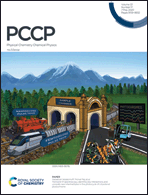 |
 |
 |
|
| Transient IR spectroscopy identifies key interactions and unravels new intermediates in the photocycle of a bacterial phytochrome
Joachim Kübel, Manoop Chenchiliyan, Saik Ann Ooi, Emil Gustavsson, Linnéa Isaksson, Valentyna Kuznetsova, Janne A. Ihalainen, Sebastian Westenhoff and Michał Maj Phys. Chem. Chem. Phys., 2020, 22, 9195 DOI:10.1039/C9CP06995J |
The mechanism of Mg2+ conduction in ammine magnesium borohydride promoted by a neutral molecule
Yigang Yan, Wilke Dononelli, Mathias Jørgensen, Jakob B. Grinderslev, Young-Su Lee, Young Whan Cho, Radovan Černý, Bjørk Hammer and Torben R. Jensen Phys. Chem. Chem. Phys., 2020, 22, 9204 DOI:10.1039/D0CP00158A |
Gas-phase action and fluorescence spectroscopy of mass-selected fluorescein monoanions and two derivatives
Christina Kjær, Rikke F. Hansson, Christinne Hedberg, Frank Jensen, Henrik H. Jensen and Steen Brøndsted Nielsen Phys. Chem. Chem. Phys., 2020, 22, 9210 DOI:10.1039/D0CP00453G |
|
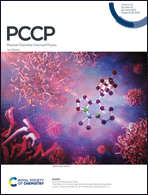 |
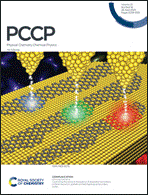 |
 |
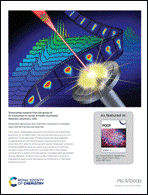 |
| The effect of solvent polarity and macromolecular crowding on the viscosity sensitivity of a molecular rotor BODIPY-C10
Artūras Polita, Stepas Toliautas, Rokas Žvirblis and Aurimas Vyšniauskas Phys. Chem. Chem. Phys., 2020, 22, 8296 DOI:10.1039/C9CP06865A |
Controlling the emission frequency of graphene nanoribbon emitters based on spatially excited topological boundary states
Xiaoyan Wu, Rulin Wang, Na Liu, Hao Zou, Bin Shao, Lei Shao and ChiYung Yam Phys. Chem. Chem. Phys., 2020, 22, 8277 DOI:10.1039/C9CP06732A |
Physical properties of new ordered bimetallic phases M0.25Cd0.75PS3 (M = ZnII, NiII, CoII, MnII)
P. Fuentealba, C. Olea, H. Aguilar-Bolados, N. Audebrand, R. C. de Santana, C. Doerenkamp, H. Eckert, C. J. Magon and E. Spodine Phys. Chem. Chem. Phys., 2020, 22, 8315 DOI:10.1039/D0CP00631A |
Expansion dynamics and chemistry evolution in ultrafast laser filament produced plasmas
Elizabeth J. Kautz, Jeremy Yeak, Bruce E. Bernacki, Mark C. Phillips and Sivanandan S. Harilal Phys. Chem. Chem. Phys., 2020, 22, 8304 DOI:10.1039/D0CP00078G |
 |
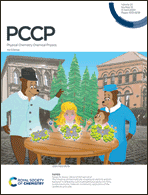 |
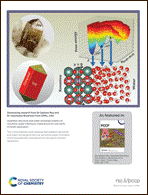 |
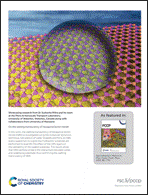 |
| Engineering work function of graphene oxide from p to n type using a low power atmospheric pressure plasma jet
Avishek Dey, Paheli Ghosh, James Bowen, Nicholas St. J. Braithwaite and Satheesh Krishnamurthy Phys. Chem. Chem. Phys., 2020, 22, 7685 DOI:10.1039/C9CP06174F |
The influence of intermolecular coupling on electron and ion transport in differently substituted phthalocyanine thin films as electrochromic materials: a chemistry application of the Goldilocks principle
Thi Hai Quyen Nguyen, Marius Pelmuş, Christopher Colomier, Sergiu M. Gorun and Derck Schlettwein Phys. Chem. Chem. Phys., 2020, 22, 7699 DOI:10.1039/C9CP06709D |
Hydration structure and water exchange kinetics at xenotime–water interfaces: implications for rare earth minerals separation
Santanu Roy, Lili Wu, Sriram Goverapet Srinivasan, Andrew G. Stack, Alexandra Navrotsky and Vyacheslav S. Bryantsev Phys. Chem. Chem. Phys., 2020, 22, 7719 DOI:10.1039/D0CP00087F |
On the wetting translucency of hexagonal boron nitride
Enrique Wagemann, Yanbin Wang, Siddhartha Das and Sushanta K. Mitra Phys. Chem. Chem. Phys., 2020, 22, 7710 DOI:10.1039/D0CP00200C |
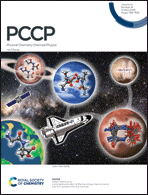 |
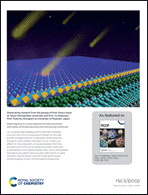 |
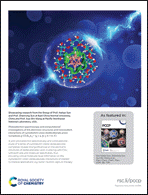 |
|
| Automated exploration of the low-energy chemical space with fast quantum chemical methods
Philipp Pracht, Fabian Bohle and Stefan Grimme Phys. Chem. Chem. Phys., 2020, 22, 7169 DOI:10.1039/C9CP06869D |
Heat trapping in a nano-layered microenvironment: estimation of temperature by thermal sensing molecules
Vivek Ramakrishnan, Yu Nabetani, Daisuke Yamamoto, Hiroshi Tachibana and Haruo Inoue Phys. Chem. Chem. Phys., 2020, 22, 7201 DOI:10.1039/C9CP05817F |
Photoelectron spectroscopy and computational investigations of the electronic structures and noncovalent interactions of cyclodextrin-closo-dodecaborate anion complexes χ-CD·B12X122− (χ = α, β, γ; X = H, F)
Zhipeng Li, Yanrong Jiang, Qinqin Yuan, Jonas Warneke, Zhubin Hu, Yan Yang, Haitao Sun, Zhenrong Sun and Xue-Bin Wang Phys. Chem. Chem. Phys., 2020, 22, 7193 DOI:10.1039/D0CP00700E |
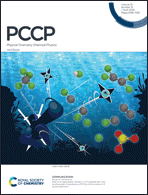 |
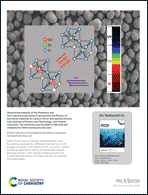 |
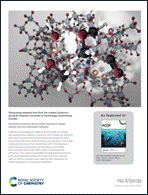 |
|
| Real-time degradation dynamics of hydrated per- and polyfluoroalkyl substances (PFASs) in the presence of excess electrons
Sharma S. R. K. C. Yamijala, Ravindra Shinde and Bryan M. Wong Phys. Chem. Chem. Phys., 2020, 22, 6804 DOI:10.1039/C9CP06797C |
Kinetic selection of nonradiative excitation in photonic nanoparticles Gd2O3:Er
Anatoly Zatsepin and Yulia Kuznetsova Phys. Chem. Chem. Phys., 2020, 22, 6818 DOI:10.1039/C9CP06876G |
Desorption products during linear heating of copper zeolites with pre-adsorbed methanol
Xueting Wang, Adam A. Arvidsson, Magnus Skoglundh, Anders Hellman and Per-Anders Carlsson Phys. Chem. Chem. Phys., 2020, 22, 6809 DOI:10.1039/C9CP05479K |
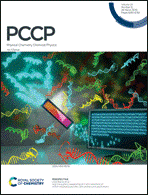 |
 |
 |
|
| High throughput sequencing of in vitro selections of mRNA-displayed peptides: data analysis and applications
Celia Blanco, Samuel Verbanic, Burckhard Seelig and Irene A. Chen Phys. Chem. Chem. Phys., 2020, 22, 6492 DOI:10.1039/C9CP05912A |
Femtosecond-to-nanosecond dynamics of flavin mononucleotide monitored by stimulated Raman spectroscopy and simulations
Prokopis C. Andrikopoulos, Yingliang Liu, Alessandra Picchiotti, Nils Lenngren, Miroslav Kloz, Aditya S. Chaudhari, Martin Precek, Mateusz Rebarz, Jakob Andreasson, Janos Hajdu, Bohdan Schneider and Gustavo Fuertes Phys. Chem. Chem. Phys., 2020, 22, 6538 DOI:10.1039/C9CP04918E |
Evidence and evolution of Criegee intermediates, hydroperoxides and secondary organic aerosols formed via ozonolysis of α-pinene
Arnab Bagchi, Youqing Yu, Jhih-Hong Huang, Cheng-Cheng Tsai, Wei-Ping Hu and Chia C. Wang Phys. Chem. Chem. Phys., 2020, 22, 6528 DOI:10.1039/C9CP06306D |
 |
 |
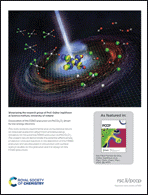 |
|
| A new non-diffusional gas bubble production route in used nuclear fuel: implications for fission gas release, cladding corrosion, and next generation fuel design
Jon M. Schwantes, Jacob L. Bair, Edgar C. Buck, Ram Devanathan, Sean H. Kessler, Timothy G. Lach, Jason M. Lonergan, Bruce K. McNamara, Camille J. Palmer and Richard A. Clark Phys. Chem. Chem. Phys., 2020, 22, 6086 DOI:10.1039/C9CP05363H |
Impact of the reaction pathway on the final product in on-surface synthesis
Antje Kutz, Md Taibur Rahman, Ville Haapasilta, Chiara Venturini, Ralf Bechstein, André Gordon, Adam S. Foster and Angelika Kühnle Phys. Chem. Chem. Phys., 2020, 22, 6109 DOI:10.1039/C9CP06044H |
Dissociation of the FEBID precursor cis-Pt(CO)2Cl2 driven by low-energy electrons
Filipe Ferreira da Silva, Rachel M. Thorman, Ragnar Bjornsson, Hang Lu, Lisa McElwee-White and Oddur Ingólfsson Phys. Chem. Chem. Phys., 2020, 22, 6100 DOI:10.1039/C9CP06633K |
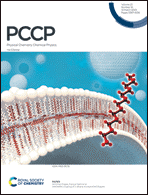 |
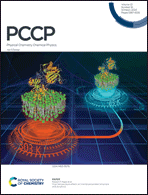 |
 |
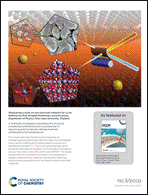 |
| Interleaflet coupling of n-alkane incorporated bilayers
Hatsuho Usuda, Mafumi Hishida, Elizabeth G. Kelley, Yasuhisa Yamamura, Michihiro Nagao and Kazuya Saito Phys. Chem. Chem. Phys., 2020, 22, 5418 DOI:10.1039/C9CP06059F |
Cryo-temperature effects on membrane protein structure and dynamics
Rukmankesh Mehra, Budheswar Dehury and Kasper P. Kepp Phys. Chem. Chem. Phys., 2020, 22, 5427 DOI:10.1039/C9CP06723J |
A microfluidic study of synergic liquid–liquid extraction of rare earth elements
Asmae El Maangar, Johannes Theisen, Christophe Penisson, Thomas Zemb and Jean-Christophe P. Gabriel Phys. Chem. Chem. Phys., 2020, 22, 5449 DOI:10.1039/C9CP06569E |
A multiscale investigation elucidating the structural complexities and electrochemical properties of layered–layered composite cathode materials synthesized at low temperatures
Songyoot Kaewmala, Narinthorn Wiriya, Patcharapohn Chantrasuwan, Visittapong Yordsri, Wanwisa Limphirat, Shoaib Muhammad, Won-Sub Yoon, Jeffrey Nash, Sutham Srilomsak, Pimpa Limthongkul and Nonglak Meethong Phys. Chem. Chem. Phys., 2020, 22, 5439 DOI:10.1039/C9CP06165G |
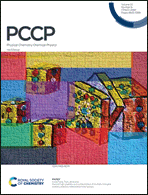 |
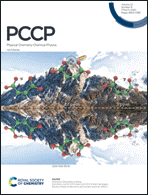 |
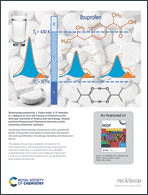 |
|
| Record-high stability and compactness of multiply-charged clusters aided by selected terminal groups
Ming Min Zhong, Hong Fang and Puru Jena Phys. Chem. Chem. Phys., 2020, 22, 4880 DOI:10.1039/C9CP06215G |
Symmetry and 1H NMR chemical shifts of short hydrogen bonds: impact of electronic and nuclear quantum effects
Shengmin Zhou and Lu Wang Phys. Chem. Chem. Phys., 2020, 22, 4884 DOI:10.1039/C9CP06840F |
Dissecting intermolecular interactions in the condensed phase of ibuprofen and related compounds: the specific role and quantification of hydrogen bonding and dispersion forces
Phys. Chem. Chem. Phys., 2020, 22, 4896 DOI:10.1039/C9CP06641A |
|
 |
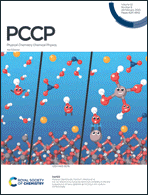 |
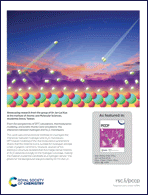 |
 |
| Benchmark ab initio and dynamical characterization of the stationary points of reactive atom + alkane and SN2 potential energy surfaces
Gábor Czakó, Tibor Győri, Balázs Olasz, Dóra Papp, István Szabó, Viktor Tajti and Domonkos A. Tasi Phys. Chem. Chem. Phys., 2020, 22, 4298 DOI:10.1039/C9CP04944D |
Ion–ion interactions enhance aluminum solubility in alkaline suspensions of nano-gibbsite (α-Al(OH)3) with sodium nitrite/nitrate
Mateusz Dembowski, Michelle M. Snyder, Calvin H. Delegard, Jacob G. Reynolds, Trent R. Graham, Hsiu-Wen Wang, Ian I. Leavy, Steven R. Baum, Odeta Qafoku, Matthew S. Fountain, Kevin M. Rosso, Sue B. Clark and Carolyn I. Pearce Phys. Chem. Chem. Phys., 2020, 22, 4368 DOI:10.1039/C9CP05856G |
From the perspectives of DFT calculations, thermodynamic modeling, and kinetic Monte Carlo simulations: the interaction between hydrogen and Sc2C monolayers
Thong Nguyen-Minh Le, Cheng-chau Chiu and Jer-Lai Kuo Phys. Chem. Chem. Phys., 2020, 22, 4387 DOI:10.1039/C9CP05796J |
Photodissociation dynamics of H2O and D2O via the (1A1) electronic state
Yao Chang, Jiami Zhou, Zijie Luo, Zhichao Chen, Zhigang He, Shengrui Yu, Li Che, Guorong Wu, Xingan Wang, Kaijun Yuan and Xueming Yang Phys. Chem. Chem. Phys., 2020, 22, 4379 DOI:10.1039/C9CP05321B |
 |
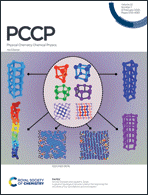 |
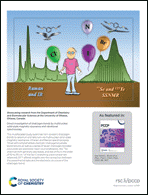 |
 |
| Importance of self-interaction-error removal in density functional calculations on water cluster anions
Jorge Vargas, Peter Ufondu, Tunna Baruah, Yoh Yamamoto, Koblar A. Jackson and Rajendra R. Zope Phys. Chem. Chem. Phys., 2020, 22, 3789 DOI:10.1039/C9CP06106A |
A general topological network criterion for exploring the structure of icy nanoribbons and monolayers
Amrita Goswami and Jayant K. Singh Phys. Chem. Chem. Phys., 2020, 22, 3800 DOI:10.1039/C9CP04902A |
Direct investigation of chalcogen bonds by multinuclear solid-state magnetic resonance and vibrational spectroscopy
Vijith Kumar, Yijue Xu, César Leroy and David L. Bryce Phys. Chem. Chem. Phys., 2020, 22, 3817 DOI:10.1039/C9CP06267J |
Hyperfine structure of the NaCs b3Π2 state near the dissociation limit 3S1/2 + 6P3/2 observed with ultracold atomic photoassociation
Xiaofeng Wang, Wenliang Liu, Yuqing Li, Jizhou Wu, Vladimir B. Sovkov, Jie Ma, Sofiia Onishchenko, Peng Li, Yongming Fu, Dan Li, Qunchao Fan, Liantuan Xiao and Suotang Jia Phys. Chem. Chem. Phys., 2020, 22, 3809 DOI:10.1039/C9CP05870B |
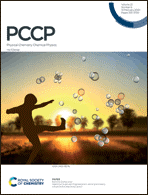 |
 |
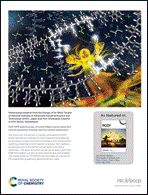 |
|
| Statistical molecular fragmentation: which parameters influence the branching ratios?
Pierre Désesquelles, Nguyen-Thi Van-Oanh, Sébastien Thomas and Dominik Domin Phys. Chem. Chem. Phys., 2020, 22, 3160 DOI:10.1039/C9CP05095G |
Control of the deprotonation of terephthalic acid assemblies on Ag(111) studied by DFT calculations and low temperature scanning tunneling microscopy
Jeanne Heintz, Corentin Durand, Hao Tang and Roland Coratger Phys. Chem. Chem. Phys., 2020, 22, 3173 DOI:10.1039/C9CP05151A |
DNP NMR spectroscopy of cross-linked organic polymers: rational guidelines towards optimal sample preparation
Shinji Tanaka, Wei-Chih Liao, Atsuko Ogawa, Kazuhiko Sato and Christophe Copéret Phys. Chem. Chem. Phys., 2020, 22, 3184 DOI:10.1039/C9CP05208A |
|
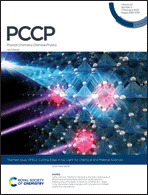 |
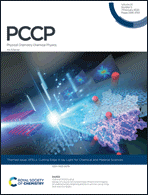 |
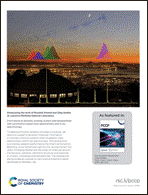 |
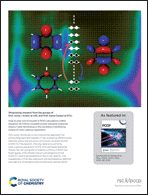 |
| Photoinduced anisotropic distortion as the electron trapping site of tungsten trioxide by ultrafast W L1-edge X-ray absorption spectroscopy with full potential multiple scattering calculations
Akihiro Koide, Yohei Uemura, Daiki Kido, Yuki Wakisaka, Satoru Takakusagi, Bunsho Ohtani, Yasuhiro Niwa, Shunsuke Nozawa, Kohei Ichiyanagi, Ryo Fukaya, Shin-ichi Adachi, Tetsuo Katayama, Tadashi Togashi, Shigeki Owada, Makina Yabashi, Yusaku Yamamoto, Misaki Katayama, Keisuke Hatada, Toshihiko Yokoyama and Kiyotaka Asakura Phys. Chem. Chem. Phys., 2020, 22, 2615 DOI:10.1039/C9CP01332F |
Design of a liquid cell toward three-dimensional imaging of unidirectionally-aligned particles in solution using X-ray free-electron lasers
Akihiro Suzuki, Takashi Kimura, Ying Yang, Yoshiya Niida, Akiko Nishioka, Tatsuro Tachibana, Masashi Takei, Kensuke Tono, Makina Yabashi, Tetsuya Ishikawa, Tairo Oshima, Yoshitaka Bessho, Yasumasa Joti and Yoshinori Nishino Phys. Chem. Chem. Phys., 2020, 22, 2622 DOI:10.1039/C9CP03658J |
From atoms to aerosols: probing clusters and nanoparticles with synchrotron based mass spectrometry and X-ray spectroscopy
Musahid Ahmed and Oleg Kostko Phys. Chem. Chem. Phys., 2020, 22, 2713 DOI:10.1039/C9CP05802H |
How to stay out of trouble in RIXS calculations within equation-of-motion coupled-cluster damped response theory? Safe hitchhiking in the excitation manifold by means of core–valence separation
Kaushik D. Nanda, Marta L. Vidal, Rasmus Faber, Sonia Coriani and Anna I. Krylov Phys. Chem. Chem. Phys., 2020, 22, 2629 DOI:10.1039/C9CP03688A |
 |
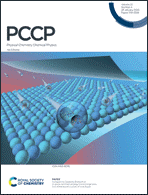 |
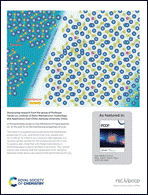 |
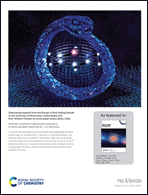 |
| Investigation of the Mn dopant-enhanced photoluminescence performance of lead-free Cs2AgInCl6 double perovskite crystals
Wentiao Wu, Wei-Yan Cong, ChengBo Guan, Hui Sun, Ruotong Yin, Gan Yu and Ying-Bo Lu Phys. Chem. Chem. Phys., 2020, 22, 1815 DOI:10.1039/C9CP05236D |
A space-confined strategy toward large-area two-dimensional crystals of ionic liquid
Yumiao Lu, Wei Chen, Yanlei Wang, Feng Huo, Lan Zhang, Hongyan He and Suojiang Zhang Phys. Chem. Chem. Phys., 2020, 22, 1820 DOI:10.1039/C9CP04467A |
A first-principles study on the influences of metal species Al, Zr, Mo and Tc on the mechanical properties of U3Si2
Haigen Gao, Yande Liu, Jun Hu and Xiong Li Phys. Chem. Chem. Phys., 2020, 22, 1833 DOI:10.1039/C9CP03814K |
Aromatic ouroboroi: heterocycles involving a σ-donor–acceptor bond and 4n + 2 π-electrons
Rodrigo Báez-Grez, Diego Inostroza, Victor García, Alejandro Vásquez-Espinal, Kelling J. Donald and William Tiznado Phys. Chem. Chem. Phys., 2020, 22, 1826 DOI:10.1039/C9CP05071J |
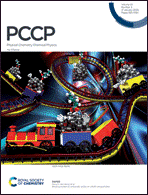 |
 |
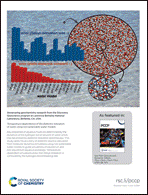 |
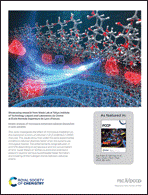 |
| Binding modes of carboxylic acids on cobalt nanoparticles
Barbara Farkaš, Umberto Terranova and Nora H. de Leeuw Phys. Chem. Chem. Phys., 2020, 22, 985 DOI:10.1039/C9CP04485J |
Spin-dependent charge transfer at chiral electrodes probed by magnetic resonance
Felix Blumenschein, Mika Tamski, Christophe Roussel, Eilam Z. B. Smolinsky, Francesco Tassinari, Ron Naaman and Jean-Philippe Ansermet Phys. Chem. Chem. Phys., 2020, 22, 997 DOI:10.1039/C9CP04681J |
Temperature-dependence of the dielectric relaxation of water using non-polarizable water models
Piotr Zarzycki and Benjamin Gilbert Phys. Chem. Chem. Phys., 2020, 22, 1011 DOI:10.1039/C9CP04578C |
Kinetic analysis of microwave-enhanced cellulose dissolution in ionic solvents
Pablo B. Sánchez, Shuntaro Tsubaki, Agílio A. H. Pádua and Yuji Wada Phys. Chem. Chem. Phys., 2020, 22, 1003 DOI:10.1039/C9CP06239D |
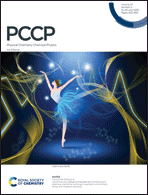 |
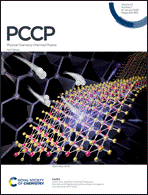 |
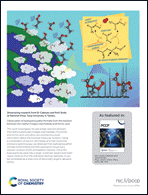 |
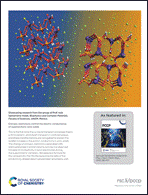 |
| Synchronously voltage-manipulable spin reversing and selecting assisted by exchange coupling in a monomeric dimer with magnetic interface
Yong-Chen Xiong, Wang-Huai Zhou, Nan Nan, Ya-Nan Ma and Wei Li Phys. Chem. Chem. Phys., 2020, 22, 422 DOI:10.1039/C9CP05316F |
Mechanism of highly enhanced hydrogen storage by two-dimensional 1T′ MoS2
Junyu Chen, Jiamu Cao, Jing Zhou, Yufeng Zhang, Mingxue Li, Weiqi Wang, Junfeng Liu and Xiaowei Liu Phys. Chem. Chem. Phys., 2020, 22, 430 DOI:10.1039/C9CP04402G |
Observation of hydroperoxyethyl formate from the reaction between the methyl Criegee intermediate and formic acid
Carlos Cabezas and Yasuki Endo Phys. Chem. Chem. Phys., 2020, 22, 446 DOI:10.1039/C9CP05030B |
Entropic restrictions control the electric conductance of superprotonic ionic solids
Iván Santamaría-Holek, Aldo Ledesma-Durán, S. I. Hernández, C. García-Alcántara, Andreu Andrio and Vicente Compañ Phys. Chem. Chem. Phys., 2020, 22, 437 DOI:10.1039/C9CP05486C |
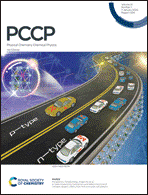 |
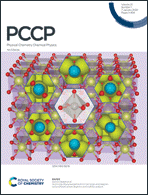 |
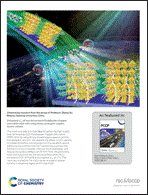 |
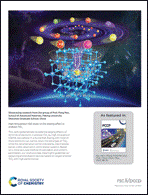 |
| p-Type conductivity mechanism and defect structure of nitrogen-doped LiNbO3 from first-principles calculations
Weiwei Wang, Yang Zhong, Dahuai Zheng, Hongde Liu, Yongfa Kong, Lixin Zhang, Rupp Romano and Jingjun Xu Phys. Chem. Chem. Phys., 2020, 22, 20 DOI:10.1039/C9CP05019A |
Atomically dispersed platinum on low index and stepped ceria surfaces: phase diagrams and stability analysis
Xing Wang, Jeroen A. van Bokhoven and Dennis Palagin Phys. Chem. Chem. Phys., 2020, 22, 28 DOI:10.1039/C9CP04973H |
Enhanced VOC of two-dimensional Ruddlesden–Popper perovskite solar cells using binary synergetic organic spacer cations
Juan Meng, Dandan Song, Di Huang, Yang Li, Yaoyao Li, Ayman Maqsood, Suling Zhao, Bo Qiao, Haina Zhu and Zheng Xu Phys. Chem. Chem. Phys., 2020, 22, 54 DOI:10.1039/C9CP04018H |
High-throughput HSE study on the doping effect in anatase TiO2
Jiahua Liu, Mouyi Weng, Sibai Li, Xin Chen, Jianhang Cen, Jianshu Jie, Weiji Xiao, Jiaxin Zheng and Feng Pan Phys. Chem. Chem. Phys., 2020, 22, 39 DOI:10.1039/C9CP04591K |



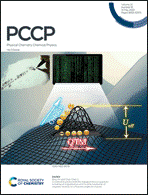
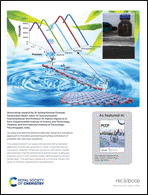
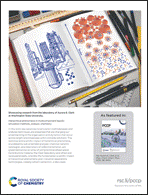










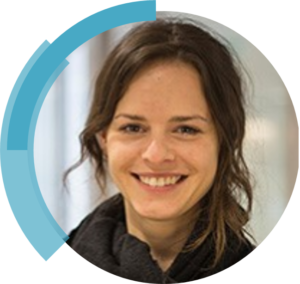

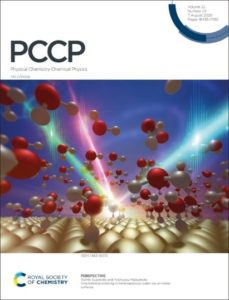
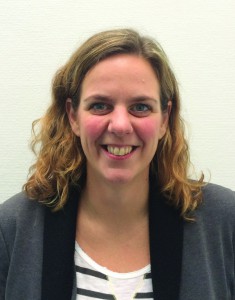
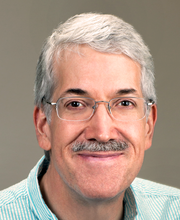
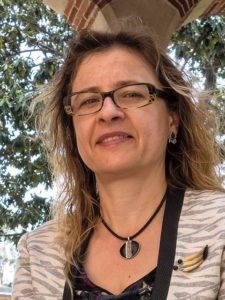 Anna Krylov (Associate Editor, PCCP)
Anna Krylov (Associate Editor, PCCP)